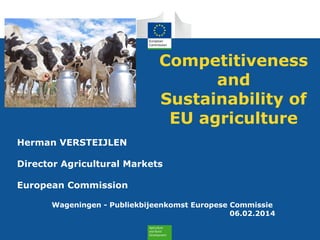Presentatie Herman Versteijlen
- 1. Competitiveness and Sustainability of EU agriculture Herman VERSTEIJLEN Director Agricultural Markets European Commission Wageningen - Publiekbijeenkomst Europese Commissie 06.02.2014
- 2. Key drivers for EU food security: 1.Enhanced competitiveness 2.Improved sustainability 2
- 3. EU competitiveness - Milk 3
- 4. Increasing demand: The main driver in the dairy outlook 4
- 5. EU exports of dairy products (in milk equivalent) in % of EU Milk production 12% 10.6% 10.2% 10.1% 10.7% 10.7% 10.7% 10.8% 10.8% 11.0% 11.1% 11% 10.3% 10% 9.5% 9.0% 9% 8% 7.7% 7% 6% 2 009 2 010 2 011 2012e 2013f 2014f 2015f 2016f 2017f 2018f 2019f 2020f 2021f 2022f Source : DG AGRI Medium Term Outlook, Eurostat (Comext) 5
- 6. EU competitiveness - Wheat 350 EU-15 EU-25 EU-25 EU-27 325 300 275 250 US SRW Wheat 225 EU Wheat Rouen 200 175 e n o t / R U E 150 125 100 75 EU cereal support price 50 25 0 2001 2002 2003 2004 2005 2006 2007 2008 2009 2010 2011 2012 2013 6
- 7. EU competitiveness - Maize 325 EU-15 EU-25 EU-25 EU-27 300 275 250 225 EU Maize Bourdeaux 200 175 e n o t / R U E 150 125 100 75 EU cereal support price 50 US 3YC Maize 25 0 2001 2002 2003 2004 2005 2006 2007 2008 2009 2010 2011 2012 2013 7
- 8. EU competitiveness - Sugar 8
- 9. The path of CAP expenditure 1980-2020 (in current prices) 70 EU-10 EU-12 EU-15 EU-25 EU-27 EU-28 60 50 -n s e c i r p t u 40 R U E o l b n i 30 20 10 0 8 9 1 8 9 1 2 8 9 1 3 8 9 1 4 8 9 1 5 8 9 1 6 8 9 1 7 8 9 1 8 9 1 8 9 1 0 9 1 9 1 2 9 1 3 9 1 4 9 1 5 9 1 6 9 1 7 9 1 8 9 1 9 1 0 2 1 0 2 0 2 3 0 2 4 0 2 5 0 2 6 0 2 7 0 2 8 0 2 9 0 2 1 0 2 1 0 2 1 0 2 3 1 0 2 4 1 0 2 5 1 0 2 6 1 0 2 7 1 0 2 8 1 0 2 9 1 0 2 0 2 0 Export refunds Other market support Market-related expenditure Decoupled direct aids Direct aids Rural development Source: DG Agriculture and Rural Development 9 Coupled direct aids 2013 = Budget (in commitments); 2014-2020 = in commitments 2014 = after transfers from P1 to P2 (before flexibility and capping)
- 10. ALTERNATIVE VIEWS ON EXPENDITURE CAP expenditure 2009 (euro) CAP expenditure in 2009 (%) 41% of EU budget 0.5% of EU GNI Source: European Commission - DG Agriculture and Rural Development 10
- 11. 1. Enhanced competitiveness 2. Improved sustainability 11
- 12. New focus of direct payments Decreasing share of CAP expenditure in EU Budget (37,8% for the years 2014-2020); Direct payments to farmers in exchange for public services & specific objectives, e.g.: Payments for green services Payments to young farmers Payments to areas with natural constraints 12
- 13. Cumulative environmental benefits The new greening architecture of the CAP m Far ry iso Adv tem Sys ean rop ion Eu vat nno rship I tne Par al ltur ic u Agr earch Res Rural development Greening Cross compliance Agricultural area (eligible for direct payments) 13 Implementation mechanism Voluntary with compensation for cost incurred and income forgone Mandatory with financial support (decoupled “green” payment per hectare) Regulatory (Statutory Management Requirements and Good Agricultural Environmental Conditions)
- 14. Standard of living of farmers compared to the standard of living of employees in the whole economy* * Standard of living of farmers as a share of the standard of living of persons employed full-time in the whole economy (calculated on the basis of entrepreneurial income/salary in EUR/hour worked) 14
- 15. Development of agricultural income in the EU-28 (average 2003-07=100) 15
- 16. Conclusions The new CAP contributes to EU food security by: • Keeping EU agriculture competitive at world level • Supporting public services: sustainability, greening However, agricultural incomes are low as compared to the rest of the Economy. Thank you for your attention !
Editor's Notes
- Sources:European Commission - DG Agriculture and Rural Development (Unit L.1) and DG Economic and Financial Affairs (AMECO database) Updated:18.10.2010 CAP expenditure and EU budget data are commitments appropriations for the year. And there are different forms of looking at CAP costs: Many argue that CAP is to costly, stating that it represents 41% of EU budget (graph on the left) (it was 52.8% in 2000). Where they forget that there are few policies which are exclusively paid by the EU budget (such as regional and cohesion funds). All the other policies are national policies. Because of this, evaluating the cost of the CAP by the share of EU budget is misleading. An alternative way of looking at the CAP cost is by the share on GDP compared with the share of the total public expenditure: the CAP represents 0.5% of the EU GDP, but all EU public expenditure represents 50.8% of the EU GDP (in blue). (2nd graph).















